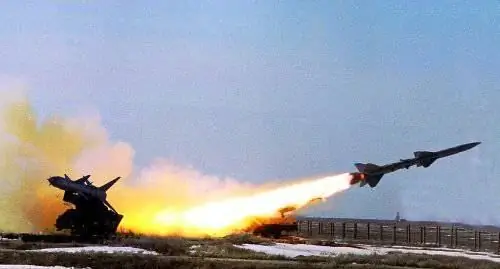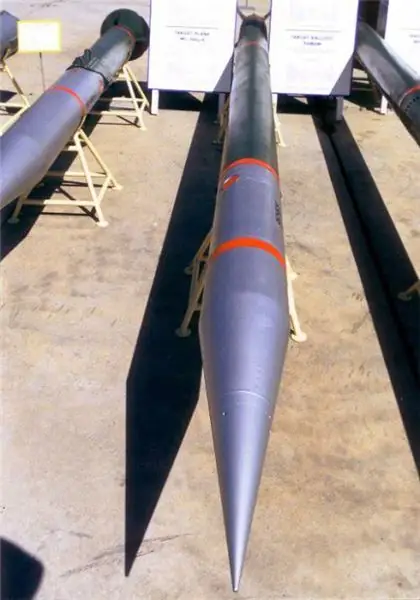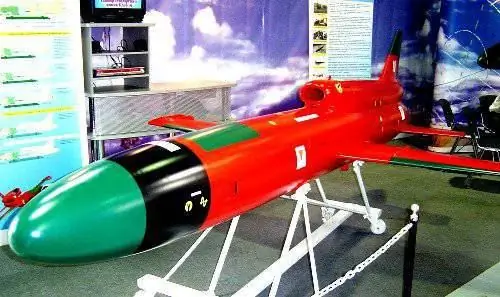- Author Matthew Elmers [email protected].
- Public 2023-12-16 21:49.
- Last modified 2025-01-24 09:17.

As you know, learning is hard. And the training itself takes a lot of time, and also requires some costs. If only cartridges and targets made of paper or plywood are needed to train an infantry submachine gunner, then training in other types of troops requires large expenses. For example, you can't make an air defense target out of paper, and operators need to be trained.
Earlier, in tests of anti-aircraft missile systems and in exercises with their use, aircraft that had exhausted their resource and were equipped with the appropriate equipment were used as targets. This approach to the creation of targets made it possible to save on the storage and disposal of outdated equipment, but over time it ceased to suit the military. If only because the potential enemy has potential targets capable of developing relatively high speeds. It would be wasteful to use aircraft with similar characteristics as their imitators. The way out of this situation was the use of specially modified anti-aircraft missiles as targets. Rockets, of course, are not very similar in size to real targets of anti-aircraft gunners, but air defense systems determine the target not by its size, but by the reflected radio signal or by thermal radiation.
As in the case of converted obsolete aircraft, the manufacture of targets from anti-aircraft missiles also allows you to get rid of unnecessary ammunition at the same time. At the moment, work is underway to alter the missiles of the S-300P and S-300T complexes in the target, because these modifications of the S-300 are no longer on duty, and there is no point in keeping them in warehouses. So we can confidently say that doubts about the advisability of decommissioning and such "disposal" of old versions of the S-300 are unjustified.
As already mentioned, anti-aircraft missiles are guided to the target using a radar or infrared homing head, and for the most effective training of personnel, it is required that the target on the radar screen looks the same as a real target. However, the anti-aircraft missile itself has a lower effective dispersion surface (EPR) and infrared signature than a combat aircraft. Therefore, when converting a rocket into a target, reflectors of various designs are almost always installed on them to increase the RCS, and sometimes special tracers to "attract the attention" of infrared seeker.
Currently, only in Russia there is a huge number of target missile models. For example, at the September Russian-Belarusian exercises "Shield of the Union-2011", held at the Ashuluk training ground (Astrakhan region), to create the so-called. target environment used more than four dozen types of targets.

Most modern targets are based on obsolete anti-aircraft missiles, although there are exceptions. These are, for example, "Kaban", created on the basis of a meteorological rocket, and "Reis" - a converted unmanned reconnaissance aircraft developed by the Tupolev company. At the same time, the purpose of these two missiles is different: "Kaban" imitates ballistic targets and flies at a speed of 800-1300 m / s, reaching a maximum height of 50 km. Its range is 90-110 kilometers. "Flight" (aka VR-3VM or M-143), in turn, is designed to simulate aerodynamic targets, such as enemy aircraft or cruise missiles flying at heights of up to a thousand meters at speeds up to 900-950 km / h.
Among other targets, the Armavir, Tit and Pishchal missiles are of particular interest. The fact is that they are made on the basis of missiles of the S-75 (the first two) and S-125 complexes, which have long been removed from duty in our country. However, these missiles can serve as targets for more than one year. RM-75 "Armavir" (developed by NPO Molniya), for example, is capable of imitating not only existing, but also promising aerodynamic targets, including subtle ones, flying at an altitude of 50 meters to 20 kilometers. The rocket's own RCS is less than half a square meter. When using an additional block of reflectors, this indicator can be increased by 3-4 times. The Armavir is launched from a standard launcher, but all procedures are controlled using the Lisa and Lisa-M complexes. The RM-75 flies according to a predetermined program, making corrections according to commands from the ground. In addition to standard control equipment and reflectors, "Armavir" can be equipped with hit registration equipment, infrared tracers or electronic countermeasures.
The targets of the Tit family (Tit-1, -6 and -23, as well as Korshun) are generally similar to the Armavir, with the difference that the Titmates have great capabilities to control the missile during flight from the ground.
The PM-5V27 Pishchal target was developed by the Vyatka machine-building enterprise Avitek on the basis of the 5V27 missile of the S-125 complex. This missile can be used as a simulator of ballistic targets, in which case it "climbs" to an altitude of 45-50 km. But the main purpose of "Pishchali" is to imitate aerodynamic targets with a small RCS, flying at low and medium altitudes, capable of maneuvering with overloads (cruise missiles, etc.). Like other target missiles, the Pishchal is launched from a standard launcher. In this case, cardinal modifications to the starting devices are not required. At the beginning of the flight, the rocket is controlled from the ground, and then goes into autonomous mode, although the operator can still correct the flight path.

And finally, a little about targets created from scratch. One of the most notable examples among them is the "Tribute" complex. This cruise missile with a turbojet engine is launched with a powder booster and can fly at altitudes from 50 to 9000 meters. The maximum flight speed is about 710-720 km / h. At the same time, the rocket is strong enough and allows maneuvering with overloads from +9 to -3 units. "Tribute", developed in the Kazan OKB "Sokol", is capable of carrying a wide range of warheads for various purposes (reflectors, electronic warfare, etc.), as well as tracers. At the end of the flight, in automatic mode or at the command of the operator, "Tribute" is able to make a soft landing by parachute. Thus, one such missile can be used up to ten times.
In general, practice shows that it is not necessary to create targets for air defense from scratch. Of course, this approach makes it possible to make them exactly what they should be. But, at the same time, the concept of converting an anti-aircraft missile into a target is viable not only in theory, but also in practice.






